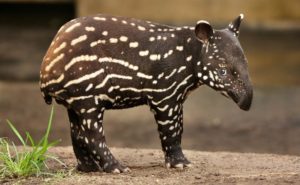Podcast: Play in new window | Download (Duration: 17:22 — 14.9MB)
This week’s episode is about a couple of mystery elephants and a non-mysterious animal, the tapir…but there might be some mystery associated with that little-trunked cutie too.
The tapir and its weird snoot:

The Moeritherium probably looked something like this:

Some super cute Borneo elephants with super long tails:

A baby tapir omgimgoingtodieofcuteomg

Show transcript:
Welcome to Strange Animals Podcast. I’m your host, Kate Shaw.
This week we’re looking at some animals with snoots. Specifically, a couple of mysterious elephants, and the tapir, which looks like what you might get if a pig and an elephant had a baby.
Usually I start episodes with the facts about a known animal and finish up with a mystery, but this week we’re starting with a strange and mysterious animal called a water elephant.
There’s only been one reported sighting of a water elephant and it’s not a recent one. In 1912, an article appeared in the Journal of the East Africa and Uganda Natural History Society. It was written by R.J. Cuninghame but concerned a Mr. Le Petit.
Now, before I go on to discuss the water elephant, let me just say that I have a great big problem with someone named M. Le Petit. No pun intended. Going by the name, and the secondhand nature of the account, and the fact that a lot of stories about strange African animals from this era are hoaxes of one variety or another, I’m taking this whole thing with a grain of salt. But it’s an interesting story, and if there really was a guy saddled with the name of little mister man, I can see why he spent a lot of time exploring the Congo instead of becoming a Shakespearian actor or something.
Anyway, I was able to find the original article, which has been digitized. It’s quite short, so instead of paraphrasing it I’ll just read the whole thing. It’s from the July 1912 issue of the journal, volume two number four, pages 97 through 98.
[read article]
There is no known animal that precisely fits Le Petit’s description. The closest is possibly the tapir. You can pronounce it taper if you want. It’s spelled T-A-P-I-R and no one seems to know how it’s supposed to be pronounced. Anyway, there are five species of tapir still around, four in Central and South America and one in Asia.
While the different species vary in size and coloring, generally a tapir is about 3 feet high at the shoulder and up to 8 feet long with short fur. The ears are oval-shaped with white tips. Its body is rounded with a pronounced rump, a stubby little tail, and a long head with a short but prehensile trunk. Superficially the tapir looks kind of like a piggy but it’s actually much more closely related to horses and rhinos. It has four toes on its front legs, three on its hind legs, and each toe has a little hoof. Depending on the species, the tapir may be gray, reddish-brown, black and white, or if it’s a baby, stripey. Females have a single pair of teats and males have a remarkably long, somewhat prehensile penis with flaps on the end that helps make a seal so it can mate underwater. You won’t get this information on National Geographic Kids, no sirree.
The tapir is a shy, largely solitary, mostly nocturnal animal that prefers forests near rivers or streams. It can bite like heck if it needs to, but it much prefers to run away from danger. Its favorite method of hiding is to submerge in water. It spends a lot of time in water, in fact, eating water plants and cooling off when it’s hot. It swims well and can use its snoot as a snorkel.
Technically its snoot is called a proboscis. It’s like a short elephant trunk although tapirs and elephants aren’t closely related. When it’s not snorkeling, the tapir uses its snoot to help gather plants. I just like saying snoot.
Tapir fossils have been discovered in Europe, China, and North America, but not Africa. So whatever M. Le Peti saw, assuming the account wasn’t a hoax or a mistaken identity, it probably wasn’t a tapir. So what else might fit the water elephant’s description?
There is an extinct animal that fits the description pretty well as far as we know. The Moeritherium lived about 35 million years ago and its fossils have been found in many parts of Africa. It was related to modern elephants although it wasn’t a direct ancestor, just an offshoot that as far as we know died out without descendants.
It wasn’t a very big animal—like the tapir, it looked more like a pig than an elephant. It stood between 2 and 3 feet high at the shoulder but was long-bodied, almost 10 feet long. Its legs were short, it may have had a tapir-like trunk, and it had small tusks more like those of a hippo, nothing like elephant tusks. Studies of its teeth indicate it ate a lot of aquatic plants, so it probably lived a lot like a hippo.
So could the water elephant be a descendant of Moeritherium? It sure sounds like a possibility, but there are two important facts to keep in mind.
First of all, the hippo evolved about 16 million years ago. If the Moeritherium had lived and continued to evolve, it’s possible it would have ended up looking a lot like the modern hippo. But the hippo is most closely related to whales—I’m not even kidding, and somehow I always manage to bring up whales no matter what animal I’m researching, huh?—and the hippo wouldn’t have become so wide-spread if the Moeritherium had a lock on the big aquatic freshwater herbivore niche.
Second, the date of the article is suspicious if you look at the discoveries of Moeritherium fossils. The Moeritherium was first described in 1901 from fossils found in Egypt. More fossils were discovered in 1902 and 1904. In 1911 the fossils were examined more closely and divided into two species. During this time, discoveries in palaeontology were popular subjects in magazines and newspapers. Dinosaurs and other extinct animals were even more a part of popular culture as they are now. Arthur Conan Doyle’s book The Lost World was published in 1912, continuing a tradition already well established by Jules Verne of science fiction stories where people discover supposedly extinct animals in remote areas. Scientists and explorers were still hopeful that living dinosaurs or ice age megafauna would be found alive and well. So it’s not a bit outlandish to suggest that the author of the water elephant story made it up with the best possible intentions—perhaps he expected to find the Moeritherium living in the Congo and wanted to excite interest in more expeditions. Or perhaps he was hoaxed by someone who’d read about the Moeritherium and thought it would make a plausible subject of a tall tale.
Clearly, I’m skeptical about the water elephant being a real animal, although I’d love to be proven wrong. But there is another definitely real elephant that might be a mystery that’s been hiding in plain sight for hundreds of years.
In 1750 or thereabouts, according to locals, a pair of elephants was given to the Sultan of Sulu who brought them to Borneo. At some point the elephants were released into the wild and their descendants now live throughout the western and northern parts of the island. This story sounds straightforward and interesting, but there are a lot of confusing details that make it less certain. Supposedly, the Raja of Java gave a pair of elephants to Raja Baginda of Sulu, but that was around 1395. We do know that in 1521, tame elephants were part of the palace’s wonders, but by the 1770s there were no tame elephants, only feral ones. Supposedly, the elephants were released into the wild at some point to keep them from being captured for use in war in the event of an invasion.
Whenever and however it happened, it sounds plausible that the elephants still living in Borneo are descendants of elephants gifted to a local ruler. Elephants have long been considered appropriate royal gifts. The story is given more weight by the fact that no elephant fossils have ever been found in Borneo, which suggests the elephants were introduced recently. The Bornean elephants have a very low genetic diversity, which would be the case if they were descendants of a single pair.
But here’s why these smallish, rather tame elephants in Borneo are such a big deal. Locals, and some researchers, think they’re the only surviving members of an otherwise extinct subspecies of Asian elephant, called the Java elephant. And they are different in appearance and behavior from other Asian elephant subspecies. They’re slightly smaller, although they’re not actually pygmy elephants as they’re sometimes called. A big male Borneo elephant may stand about eight feet tall at the shoulder while a big male Asian elephant may reach close to 10 feet. The Borneo elephant’s tusks are straighter than other Asian elephants—some males don’t have tusks at all—and their tails are so long that in some individuals, they actually touch the ground. Roughly 2,000 Borneo elephants remain on the island, although their habitat is increasingly being lost to palm oil plantations. Poaching is also a problem.
Borneo and Java are both part of the Malay Archipelago in southeast Asia, which is full of islands and nations I’ve mostly only ever heard about in songs and stories, like Singapore and Sumatra, Indonesia and Papua New Guinea. I bet it’s beautiful out there, wow. Java is over 800 miles south of Borneo, so it’s not like the elephants could get there without human help. And the Java elephant was extinct by the 1800s.
In 2003, DNA testing on the Borneo elephants indicated they were not related to other Asian subspecies of elephant and were either from Java or native to Borneo. Since Borneo was cut off from the Asian mainland and the rest of the Malay Archipelago around 18,000 years ago, when sea levels rose due to melting glaciers, that means the elephants must have been on the island for at least 18,000 years if they truly are a native subspecies. But if that’s the case, where are the fossil and subfossil remains? Why do the locals insist that the elephants were introduced only hundreds of years ago?
I tried very hard to find information about DNA testing supposedly underway in 2015, but without luck. It could be that the results haven’t yet been analyzed or that the analysis hasn’t yet been published. But my bet is that the locals are right and these are Java elephants, once owned by kings.
To bring things back around to where we started, more or less, in November of 1975 a young tapir was supposedly captured in Borneo. Unfortunately, no one knew what they’d caught—the papers were described as a mixture of various types of animals, such as a tiger’s body, an elephant’s trunk, a goat’s legs but claws like a chicken’s, and so forth. Put that way it sounds absurd and made up. The papers dubbed it a tigelboat. But as zoologist Karl Shuker points out in his blog, everything about the tigelboat fits the characteristics of a young Malayan tapir. Tapir babies are stripey, and while tapirs have hooves, they do have a claw-like appearance since the toes are widely spread and the hooves pointed.
Unfortunately, no one in the scientific community followed up on the animal’s capture and it’s not known what happened to it. It was kept at a prison but wasn’t cared for and eventually disappeared. Someone probably ate it, that’s my guess. But it’s possible that tapirs still live in the swamps and rainforests of Borneo. We know they lived on the island during the Pleistocene.
Finally, one last mystery tapir was supposedly seen in New Guinea in 1906, when two New Guinea natives were employed as scouts for an expedition. The two were sent ahead to check on a trail but had to be rescued after a terrifying encounter with what they called devil-pigs. There were two of the animals, and the description sounds exactly like dark gray or black tapirs. But tapirs don’t live in New Guinea—as far as we know.
Papua and Papua New Guinea make up an island about 1,900 miles away from Borneo, so it’s not a close neighbor by any means, but it is part of the same archipelago. During the ice ages of the Pleistocene, when so much of the world’s water was locked up in glacial sheets and the sea levels were therefore much lower, the 25,000 or so islands that make up the Malay Archipelago were connected to each other and to the Asian mainland. When the oceans rose again some 18,000 years ago animals were stranded on the islands and have since either died out or adapted to their smaller territories. Who knows what secrets these little pockets of the ancient world may still hide?
You can find Strange Animals Podcast online at strangeanimalspodcast.com. We’re on Twitter at strangebeasties and have a facebook page at facebook.com/strangeanimalspodcast. If you have questions, comments, or suggestions for future episodes, email us at strangeanimalspodcast@gmail.com. If you like the podcast and want to help us out, give us a rating and review on iTunes or whatever platform you listen on. We also have a PAYtreon if you’d like to support us that way. Rewards include exclusive twice-monthly episodes and stickers.
Thanks for listening!